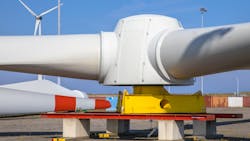How offshore drilling rigs are being repurposed for the green revolution
The offshore wind industry has experienced significant growth in the past couple of years due to the energy transition picking up pace and the subsequent heavy investment in alternative energies. As turbine and project numbers and sizes grow, demand for specialized wind installation vessels (WIVs) is set to reach new highs and with current limited capacity it's expected that there will soon be an undersupply of vessels.
Today there are ten WIVs under construction. There are a few more purpose-built units planned but construction on the majority of these has not yet begun and have therefore been excluded from Figure 1 below. More units will be needed to help install the growing backlog of ordered turbines, especially vessels big enough to be able to accommodate the increasing size of these assets too.
Figure 1: List of specialized wind installation vessels currently under construction. Source: Esgian Wind Analytics.
Drilling rigs converted for offshore wind
In 2017, Boskalis purchased Transocean’s idle 2000-built ultra-deepwater drillship GSF Jack Ryan for a reported USD 8 million with the sole purpose of converting it for offshore wind installation. The drillship, now renamed Bokalift 2, is currently at Drydocks world in Dubai. The vessel is due to be finished in by early 2022 and will be put to work at the Changfang and Xidao projects in Taiwan. Copenhagen Infrastructure Partners awarded Boskalis a deal valued between EUR 150-300 million for the two projects, covering the installation of 62 jackup foundations and 186 pin piles.
Meanwhile, earlier this year, SinoOcean, entered into an agreement with a local Chinese company to convert and bareboat charter two idle jackups for work at offshore wind farm installations in Chinese waters. In addition, SinoOcean also reportedly plans to convert an offshore tender rig for the same purpose.
Similarly, CIMC Raffles recently completed the conversion of a stranded jackup also to work locally in China.
How does a drilling rig become an offshore wind vessel?
Vessel requirements for offshore wind installation and offshore drilling are substantially different and most operations demand different assets. Offshore wind installation vessels need heavy lifting and deck space capabilities and a hull designed to accommodate a good speed.
To prepare rigs for their move into renewables, the hull can be enforced, the deck space increased, and heavy lifting capabilities installed. For example, on Bokalift 2, the former drillship will have 9,000 mt of steel blocks installed on both sides to increase its stability and have a new work deck put in place. The drillship will also have a new 4,000 mt Huisman crane installed, capable of lifting structures 100m above the deck.
The stranded Chinese jackups appear to need less upgrading for their transition into the wind market. It is understood that the two units have had their rig towers and beam cantilevers removed, while the deck has been modified and a crane with heavy-lifting capabilities now installed.
The SinoOcean tender rig is to be stripped of its drilling equipment and replaced with a 400 mt crane. The vessel is suited for shallow-water operations, making it ideal for offshore wind operations.
Conversion versus construction: the pros and cons
Although converted drilling rigs might not be as efficient as a special purpose-built WIV, they do have their benefits. Converting rigs is potentially less costly than ordering a newbuild. Also, while the construction of a brand new WIV could take up to three years to complete, a conversion (particularly in the case of jackups) takes less time.
Based on data from Boskalis’ financial reporting we estimated that the Bokalift 2 conversion costs will be in the EUR 100-200 million range, or less than half the cost of a specialized newbuild.
Installation jobs undertaken by ex-rigs may be simpler than those done by purpose-built units, due to their lack of mobility and deck space capacity. Even so, converted rigs will serve other important roles needed in the offshore wind segment. The market seems to have focused on vessels capable of installing turbines rather than foundation installation. These converted rigs can help fill the supply void until the industry builds more specialized foundation vessels, such as Alfa Lift, Les Alizes, and Green Jade.
A growing trend?
As aforementioned, the majority of rig to WIV conversions have happened in China, for the benefit of Chinese projects, as companies scramble to secure any vessel capable of working in offshore wind before government subsidies end in November this year.
Outside of China, the market undoubtedly feels the pressure of lack of WIV availability, yet these other areas have time to spare for more specialized newbuild vessels to enter the market. These converted rigs so far remain limited in numbers and are unlikely to be part of the long-term solution as the offshore wind vessel sector will remain a highly specialized market, requiring purpose-built units.
